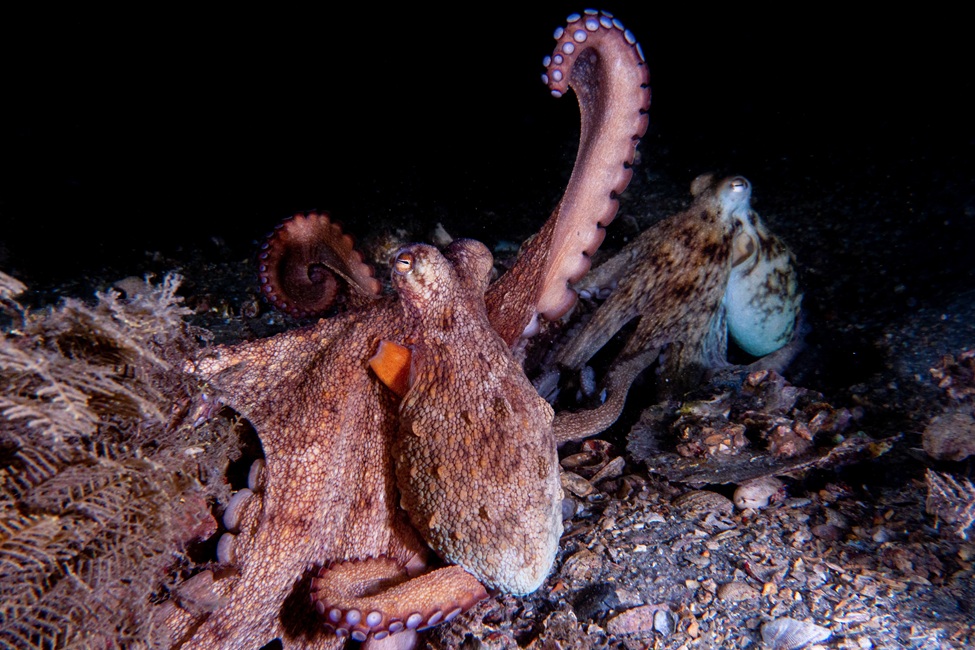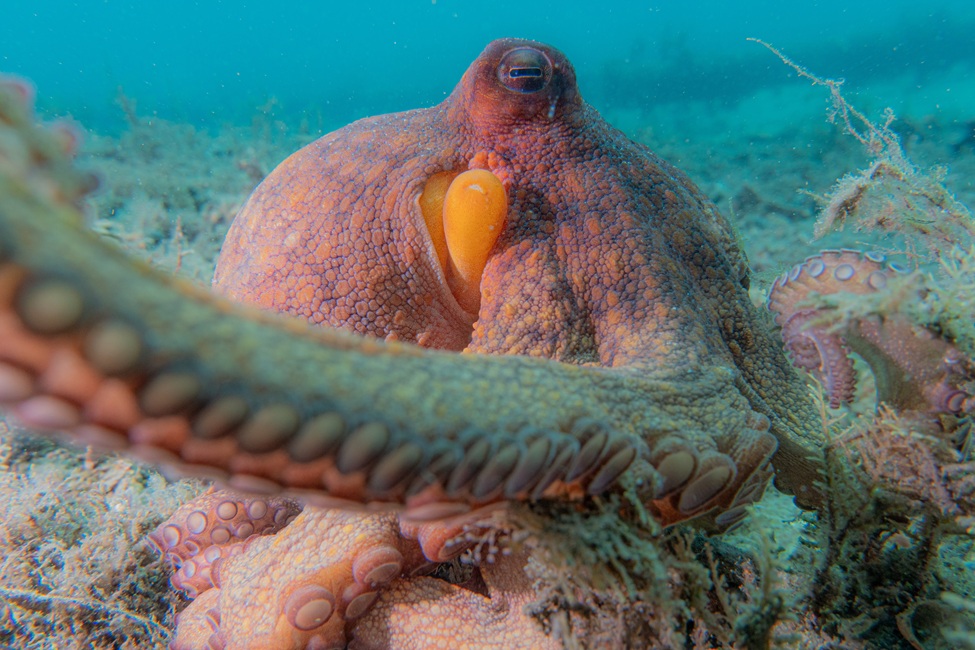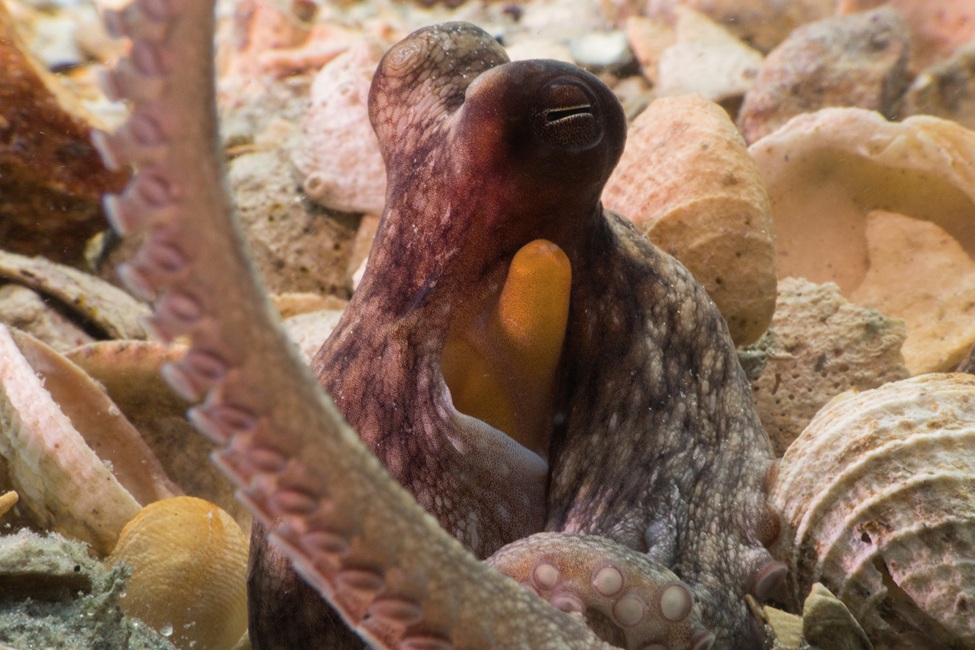Research Characterizes Remarkable Skills of Octopus Arms in the Wild

An octopus raises its arm. (Photo credit: Chelsea Bennice, Florida Atlantic University)
Octopuses are among the most neurologically complex invertebrates, famed for their extraordinary dexterity. Their eight arms allow them to capture hidden prey, communicate, explore, and even mate across varied habitats.
Although octopus arms rank among some of the most flexible structures in nature, their full range of movement has rarely been studied in the wild – especially in a range of underwater habitats.
A new study by Florida Atlantic University’s Charles E. Schmidt College of Science, in collaboration with researchers from the Marine Biological Laboratory in Woods Hole, Massachusetts, provides a comprehensive look into how wild octopuses use their arms in natural habitats. By analyzing arm movements across diverse environments, this is the first study to relate arm movements to whole animal behaviors in complex, real-world settings.
The findings, published this week in Scientific Reports, reveal that every arm is capable of performing all action types; however, there was a clear pattern of arm partitioning: front arms mainly use movements to aid in exploration, while back arms use movements that primarily support movement.
Additionally, the octopuses demonstrated remarkable flexibility – single arms were shown to perform multiple arm movements simultaneously and different arm movements were coordinated across several arms, showcasing their complex motor control.
“Observing them in the wild, we saw octopuses use different combinations of arm actions – sometimes just one arm for tasks like grabbing food, and other times multiple arms working together for behaviors like crawling or launching a parachute attack – a hunting technique they use to catch prey,” said Chelsea O. Bennice, Ph.D., lead author and a research fellow at FAU’s Marine Laboratory, Charles E. Schmidt College of Science.
Researchers quantified nearly 4,000 arm movements from 25 video recordings of three wild octopus species observed in six distinct shallow-water habitats – five located in the Caribbean and one in Spain. They identified 12 distinct arm actions across 15 behaviors, each involving one or more of four fundamental arm deformations: shortening (arm length decreases), elongating (arm length increases), bending (arm curves) and torsion (twisting).
“When octopuses move across an open environment, they skillfully use multiple arms to stay camouflaged from predators, such as the moving rock trick or looking like floating seaweed,” said Bennice. “Beyond foraging and locomotion, their arm strength and flexibility are essential for building dens, fending off predators, and competing with rival males during mating. These versatile abilities allow octopuses to thrive in a wide range of habitats.”
In the nearly 7,000 observed arm deformations, all four types – bend, elongate, shorten and torsion – were seen in every arm. However, different regions of each arm – proximal (closest to the body), medial (middle section) and distal (tip) – were found to specialize in specific types of arm deformation, reflecting a sophisticated level of functional specialization; bends mostly occurred near the tips, whereas elongations were more frequent closer to the body.
“I’m a strong believer that you have to get into the natural world, and especially the sensory world, of whatever animal you study,” said Roger Hanlon, Ph.D., co-author and senior scientist, Marine Biological Laboratory in Woods Hole. “The fieldwork is very arduous, and it takes a lot of luck to get valid natural behaviors.”
The six octopus habitats in this study varied from smooth, sandy seafloor to highly complex coral reef environments.
“Understanding these natural behaviors not only deepens our knowledge of octopus biology but also opens exciting new avenues in fields like neuroscience, animal behavior and even soft robotics inspired by these remarkable creatures,” said Bennice.
Study co-authors are Kendra C. Buresch, a marine biologist; Jennifer H. Grossman; an undergraduate student, and Tyla D. Morano, all with the Marine Biological Laboratory in Woods Hole.
This research was supported in part by the Sholley Foundation, the Ben-Veniste Family Foundation, and the United States Office of Naval Research.
//
Video credit: Chelsea Bennice, Florida Atlantic University and Roger Hanlon, Marine Biological Laboratory, Woods Hole

A common octopus in South Florida waters. (Photo credit: Chelsea Bennice, Florida Atlantic University)

An octopus Americanus. (Photo credit: Chelsea Bennice, Florida Atlantic University)
-FAU-
Latest Research
- 'Frazzled' Fruit Flies Help Unravel How Neural Circuits Stay WiredFAU scientists have discovered that the protein Frazzled (DCC in humans) fine-tunes neuron connections, keeping signals fast and precise - key to a fruit fly's rapid escape reflex and healthy nervous system.
- FAU Innovation Pilot Awards Drive Faculty Research from Lab to MarketThe FAU pilot program offers $500 to $15,000 in seed funding to help researchers turn early discoveries into market-ready technologies, fostering prototypes, industry partnerships and real-world impact.
- Nearly 70 FAU Faculty Named Among World's Top 2% of ScientistsNearly 70 FAU faculty are ranked among the world's top 2% of scientists by Stanford-Elsevier, recognizing their global research impact across 22 fields and 174 subfields from engineering to humanities.
- FAU Researchers Make Great 'Strides' in Gait Analysis TechnologyA first-of-its-kind study explored whether more accessible technologies such as a 3D depth camera could accurately measure how people walk, offering a practical alternative to traditional gait analysis tools.
- FAU Historian Traces How U.S. Nursing Homes Evolved into Big BusinessA historian explores how the Americana Corporation shaped modern nursing homes, revealing how architecture tied aging, care and profit into a system that still defines long-term care in the U.S. today.
- Where a Child Lives - Not Just Diet - Raises Type 2 Diabetes RiskFAU researchers found poor walkability, litter, and reliance on assistance programs are strongly linked to type 2 diabetes risk in young children, based on a large nationwide study.






